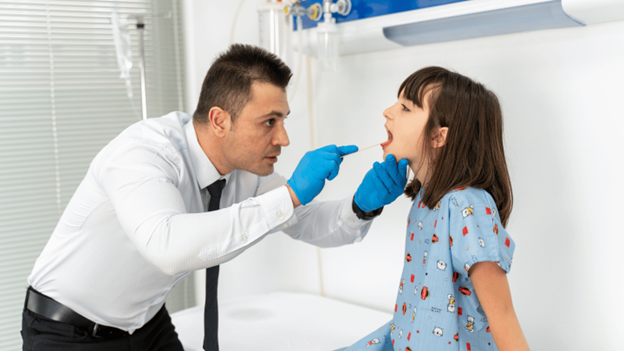
How contagious is strep throat? What parents need to know this school year.
Every parent dreads that call from the school nurse. Your child has a sore throat, feels miserable, and suddenly you're wondering if it's just a cold or something more serious. When strep throat hits, it doesn't just affect one kid; it can tear through classrooms like wildfire.
Understanding how contagious strep throat really is can help you make better decisions about when to keep your child home, when to seek treatment, and how to protect the rest of your family. The answer isn't as straightforward as you might think, and timing makes all the difference.
What is strep throat, and why it spreads so easily at school.
Strep throat isn't caused by a virus like most sore throats. It comes from a bacterial infection, specifically Group A Streptococcus bacteria. This matters because bacterial infections behave differently from viral ones, and they spread in ways that make schools perfect breeding grounds.
How does strep spread?
The bacteria live in the nose and throat, so every time an infected person talks, coughs, sneezes, or even laughs, they release tiny droplets containing the bacteria into the air. Other kids breathe in these droplets or touch contaminated surfaces and then touch their mouth or nose.
Why are schools such hotspots for strep?
Schools create ideal conditions for strep to spread. Kids sit close together, share supplies, and let's be honest, hand hygiene isn't always their top priority.
Water fountains, doorknobs, playground equipment, and cafeteria tables all become potential transmission sites.
Can kids spread strep without feeling sick?
What makes strep particularly tricky is that some children can carry the bacteria without showing symptoms. These "carriers" feel fine but can still spread strep to others.
This means your child might catch strep from a classmate who doesn't even seem sick.
How long do strep bacteria survive on surfaces?
The bacteria are also surprisingly hardy. They can survive on surfaces for hours or even days under the right conditions.
That pencil your child borrowed or the basketball they passed around during gym class could harbor strep bacteria long after an infected child touched it.
Which kids are most at risk?
Unlike some illnesses that mainly affect younger children, strep throat commonly strikes school-age kids between 5 and 15.
Their immune systems are still developing, and they haven't built up resistance to all the different strains of strep bacteria they'll encounter.
How long is strep throat contagious in kids?
Here's where timing becomes crucial. Children with untreated strep throat remain highly contagious for 2 to 3 weeks after symptoms begin. During this time, they're essentially walking germ factories, capable of infecting anyone they come into close contact with.
Without treatment: 2-3 weeks.
Children with untreated strep throat remain highly contagious for 2-3 weeks after symptoms begin. During this time, they're essentially walking germ factories, capable of infecting anyone they come into close contact with.
With antibiotics: 24 hours.
However, antibiotic treatment changes everything dramatically. Once your child starts taking prescribed antibiotics, they typically become non-contagious within 24 hours.
But even if your child feels better after just one dose of antibiotics, they can still spread strep during that first day of treatment. Many parents make the mistake of sending their child back to school too early because symptoms improve quickly.
How to prevent strep throat in the classroom and at home.
Prevention starts with understanding that strep spreads through respiratory droplets and contaminated surfaces.
While you can't control everything your child encounters at school, you can teach them habits that reduce their risk.
- Hand hygiene. Teach thorough hand washing with soap and warm water for at least 20 seconds, especially before eating, after using the bathroom, and after coughing or sneezing.
- Don't share personal items. Avoid sharing water bottles, utensils, lip balm, and anything that touches the mouth or face.
- Cough and sneeze etiquette. Kids should cough or sneeze into their elbow, not their hands. If they use tissues, they should throw them away immediately and wash their hands afterward.
- Home cleaning. Disinfect frequently touched surfaces like doorknobs, light switches, bathroom fixtures, and electronics. Pay special attention to shared spaces like the kitchen and family room.
- Immune system support. Ensure your child gets adequate sleep, nutritious meals, and regular physical activity. Well-rested, healthy kids are better equipped to fight off infections when exposed.
- Know when to seek help. If your child shows signs of strep throat (sudden severe sore throat, fever, difficulty swallowing, or swollen lymph nodes), seek medical attention promptly. Early treatment prevents complications and stops the spread to others.
When to visit urgent care for strep throat.
Strep throat requires professional diagnosis and antibiotic treatment. Unlike viral sore throats that resolve on their own, strep won't get better without medication and can lead to serious complications if left untreated.
If your child develops a severe sore throat with fever, especially if they have trouble swallowing or their voice sounds muffled, don't wait to see if it improves. Rapid strep tests can provide results in minutes, and early treatment prevents the infection from worsening or spreading.
If your child has been diagnosed with strep throat and needs prompt treatment, visit your nearest CityMD location.
Our providers can perform rapid testing, prescribe appropriate antibiotics, and help get your child back to school safely. No appointment needed.
We're here to help families stay healthy all school year long.

We’re ready to care for you.
Visit any CityMD urgent care location in your community today for an evaluation with one of our expert providers.